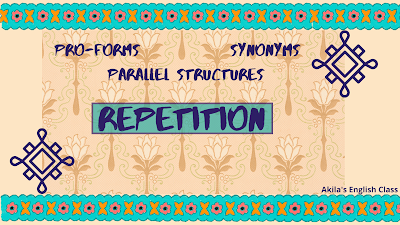4 elegant and simple ways to achieve Coherence in writing
Repetition
Pro-forms
Synonyms
Parallel structures
Coherence is the bridge that gets your thoughts and ideas begin, connect
with each other and move around smoothly
in your writing. It is that glue that holds your writing together. We have
already seen how transitional expressions are the bridges in your writing in
the post How to achieve coherence in your writing - with Transitional expressions as Bridges.
Let us see the other 4 elegant yet simple ways to achieve coherence.
Repetition
Repetition of key word(s) / phrase is an elegant and yet a simple way to achieve coherence.
Repetition
helps in maintaining the focus of the writer as well as the reader. Locate the word
/ phrase that highlight the topic of a paragraph. Repeating this word or phrase is the glue to keep the paragraph
united. Repeating such a word also
keeps the reader focussed on the main point. Repeat a key word / phrase from the final sentence of a
paragraph to refer back to the topic sentence and/or lead into the following
paragraph.
The above example very clearly throws light
on how repetition is used to achieve coherence in writing.
Pro-forms
Using pro-forms is another elegant way to achieve coherence in writing. Pro-forms are elegant as they do away with repetitive expressions.
Pro-form is a word that substitutes another word/phrase/clause/sentence. The word or word group that is replaced is the antecedent. Pro-forms are used to avoid repetitive expressions or in quantification (limiting the variables of a proposition).
In English, pronouns are the most common
pro-forms.
Pro-forms are divided into several categories, according to which part of speech they substitute:
A pro-noun is a word that substitutes a noun or a noun phrase. All pro-nouns are pronouns, but some pronouns are not pro-nouns. For instance:
My neighbour's lost his father recently. This
made me feel sad.
The pronoun this refers to the previous sentence, and is a pro-sentence, not a pro-noun.
Vijay is my best friend. I met him when I was 4 years old.
Here Vijay is the
antecedent of him.
A pro-adjective substitutes an adjective or a phrase that functions as an adjective.
Her terrace garden is big. Mine is too.
Her terrace garden is
big. So is mine.
A pro-adverb substitutes an adverb or a phrase that functions as an adverb.
(did stands for danced, and is a pro-verb).
They jog regularly. So do I.
Where ‘do’ replaces jog.
He is flying to Chennai. I may too. The word may is a pro-verb in the above sentence.
Synonyms
Using Synonyms is another elegant yet simple way to achieve coherence in writing.
Cinema is very common form of entertainment in
India. Almost everyone is entertained by cinema and enjoys it for nearly three
hours. At first silent and black and white movies were made. Then came the
talkies (motion picture with sound track) followed by coloured movies. Seeing a
film is not as expensive as some other sources of entertainment.
Parallel structures
Parallel structures add elegance, clarity, rhythm and
of course coherence to writing.
This grammatical form can be used with a variety of structures including gerunds,
infinitives, clauses and lists.
Parallel structure means using the same pattern of words to show that two or more
ideas have the same level of importance. This can happen at the word, phrase, or
clause level. Using parallel structures makes reading and processing information
easier.
If there are two or more numbers of information in a sentence, grammatical form
of the first information must be followed to express the remaining ideas.
Use gerund (-ing form)
Vijay likes singing, dancing and acting.
Use infinitive
forms
or
Vijay likes to sing, to sing and to act.
Parallel structures using clauses
Correct : The doctor told him that he needs to
take medicines regularly and that he should exercise every day.
Incorrect: The doctor told him to study and that he should exercise everyday.
Parallel structures using lists:
Very often we use bulleted lists or a list of
items following a colon. The items listed thus need to follow parallelism to be balanced,
synchronised and elegant. Such items are easy to read and simple to understand.
While listing items make sure that
* nouns go with nouns
* verbs go with verbs
* adjectives go with adjectives
* phrases go with phrases
* clauses go with clauses.
* Same verb tense go together (present, past,
future)
* Same voice go together (active, passive)
* Same sentence type (interrogation, statement)
Example:
Correct : I have two bedrooms, a guest room and a
garden in my house.
Not so correct : I have two bedrooms, a room for guests and a
garden in my house.
Example:
The school had advised the students to:
* Come to school in proper uniform.
* Reach school before the morning assembly.
* Bringing your text books and notebooks is
mandatory.
Huh! You had to read twice to understand the
above instructions. The first two begin with verbs and the last one is in the –ing form (gerund).
The same can be better understood when rewritten like this-
The school had advised the students to:
* Come to school in proper uniform.
* Reach school before the morning assembly.
* Bring your text books and notebooks
positively.
A well remembered slogan using parallelism for practicing the 3 R's of waste management.
Reduce, Reuse, Recycle
Swami Vivekananda knew the power, elegance and simplicity of parallelism to
reach his audience when he said:
So does Julius Caesar when he said:

This work is licensed under a Creative Commons Attribution 4.0 International License.











.png)
0 Comments